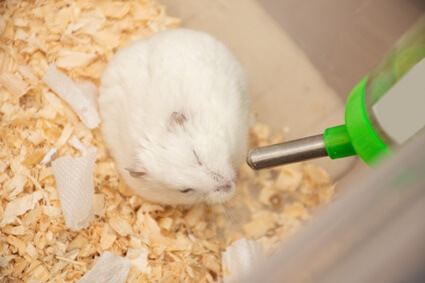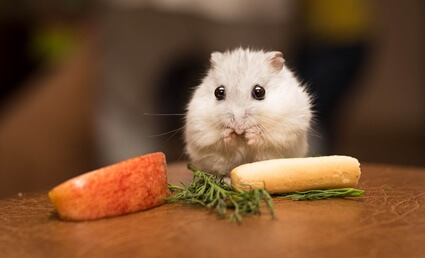Last Updated on: 24th September 2023, 07:04 pm
As hamsters grow old, they need more focused care and attention. Senior hamsters are prone to health conditions and struggle to move around, eat, and drink sufficiently.
So, provide access to food, water, and clean bedding. Senior hamsters sleep more often. While you mustn’t disturb them while they rest, check on them occasionally to ensure they’re doing okay.
What Are the Signs of Old Age in Hamsters?
While some hamsters die suddenly and without warning, most slow down and age quickly.
Elderly hamsters deteriorate faster than many of us expect. Their behavior and appearance change during the later stages of life, highlighting their elevated life cycle.
When hamsters grow old and deteriorate, they display the following signs:
- Dry skin.
- Overgrown teeth.
- Difficulty walking.
- Swollen and painful joints (arthritis).
- Losing fur.
- Slow and jerky movement.
- Decreased activity levels.
- Little interest in exercise.
- Muscle disorders.
- Weight loss.
- Deteriorating vision.
- Loss of appetite.
- Drinking less frequently.
- Pooping or peeing on itself.
Some symptoms will make hamsters feel uncomfortable, and they’ll worsen over time.

How Long Do Hamsters Live?
Hamsters only have short lifespans, living for 2-3 years on average in captivity. This equates to approximately 1 human year every 14 days hamsters live.
However, life expectancy depends on the hamster’s species and health. Also, environmental conditions have a large part to play in how long a hamster lives.
The average lifespans for each species are documented below:
| Hamster Species | Average Lifespan | Short, Average, or Long |
| Roborovski | 3 to 3.5 years | Long |
| Chinese | 2 to 3 years | Long |
| Syrian | 2 to 2.5 years | Average |
| Campbell’s Dwarf | 2 years | Average |
| Winter White Russian Dwarf | 1.5 to 2 years | Short to average |
| Hairless | 6 months to 1 year | Short |
Hamsters don’t live long because their bodies aren’t as effective as other animals at maintaining biological processes.
Over time, the cells, tissue, and organisms inside the body become less efficient. As hamsters are prey animals, they rely on procreation to survive, which requires significant energy and resources.
This even applies to captive hamsters living alone. As a result, their bodily resources are allocated to procreating, causing them to die sooner than larger animals.
Other factors cause hamsters to die earlier than other animals, including:
- Stressful situations.
- Extreme temperatures (too hot or cold).
- Prolonged exposure to bright lights and loud noises.
- Accidents and injuries, like dangerous cages and wheels.
- Health conditions, including wet tail and Cushing’s disease.
- Predatory pets, like cats and dogs.
Once a hamster reaches its senior years, there’s little you can do other than ensure it’s comfortable.
How To Care for An Elderly Hamster
Hamsters significantly slow down once they reach the later stages of their lives.
Therefore, knowing how to look after an old hamster is essential in making the final days as pleasant as possible. Keep conditions comfortable with the following steps:
Comfortable Temperature
Elderly hamsters struggle to maintain their body temperature as well as they did when young.
The optimal temperature for hamsters is 65-75 degrees Fahrenheit. Anything outside this range – whether too hot or cold – can be dangerous, especially if the hamster has an illness.
Owners with glass tanks must be more vigilant when caring for their elderly hamsters.
As explained by Popular Science, glass traps heat up fast and can make conditions too warm. However, all cages can become too hot or cold if the conditions outside them aren’t right.
Ensure a hamster’s not in direct sunlight, and use a small heater to warm the room in winter. A temperature gauge will help you optimize a hamster’s living conditions.
Smaller Cage
Elderly hamsters don’t move around much in the later stages of life.
As a result, they don’t need so much space. Too much space can negatively impact your hamster, as it can become too tired from moving to different parts of the cage.
If you observe the hamster struggling to move around, transition it to a smaller cage to make life easier. However, only do this if the hamster has little energy left.
When downgrading the cage, don’t go below 450 square inches of floor space (not including upper sections). This is the bare minimum size – anything smaller is unsuitable, even for elderly hamsters.
Clean Cage
Keep a senior hamster’s enclosure clean to prevent bacterial growth.
Wipe plastic and ceramic accessories with soapy water once a week and check for water leaks from bottles. Mold can grow on the bedding otherwise and make the hamster unwell.
Hamsters get stressed with cage cleans because it removes their scent. However, because hamsters sleep more often, their nests must be kept clean and sanitary.
Remove urine-soaked bedding and leave the clean substrate to maintain the hamster’s scent.
Quiet Environment
Elderly hamsters are more stressed by excessive noise, so keep the environment quiet so they can sleep and conserve energy.
This may involve moving the cage to a more peaceful part of the house.
Remove Unnecessary Items
Hamsters with muscle and joint issues struggle to get around, so removing unnecessary accessories, like the wheel and tubes, is recommended to prevent injuries.
Also, level out the cage to reduce the heights your hamster needs to climb.
Affection
Not only does affection benefit you, but as Physiology explains, hamsters release a neurochemical called oxytocin when touched, making them feel comfortable and relaxed.
Many hamsters enjoy being picked up and held, but this could change in the later stages if the hamster has a health condition. Gauge the hamster’s mood before initiating any interaction.
If you can’t handle the hamster physically, you can sit with it and talk to it in a soft, gentle voice. A senior hamster will take comfort from your presence and know you’re keeping it company.
Food
Old hamsters eat the same as young hamsters, although they don’t eat as much.
Senior hamsters become pickier about what they eat as they age. As a result, some hamsters need softer foods. Examples of hamster-safe soft foods include:
- Porridge cooked with water.
- Fresh vegetables.
- Cooked chicken.
- Plain-cooked eggs.
- Cooked wholegrain pasta.
- Steamed brown rice.
- Pureed baby food.
Restrict these foods by feeding only a small amount each day.

What Do Old Hamsters Need in Their Cage?
Cage organization is vital during the final stages of a hamster’s life.
Old hamsters are less likely to move around and explore, so they don’t need as many things as young hamsters. That said, they still need to maintain a quality of life.
Ensure the hamster’s enclosure has the following:
Bedding
Old hamsters need soft bedding, like shredded paper or aspen shavings. As they get tired more quickly, they sleep more often, so paper-based bedding keeps them comfortable.
Reduce the amount of bedding in the cage to make it easier to create burrows.
Don’t change the bedding too often to avoid removing the hamster’s scent. You can avoid spot-cleaning the cage more frequently while doing fewer large cage cleans.
Food and Water
Fresh water is particularly important for preventing dehydration in old age.
Most hamsters have a small stash of food they can eat in their burrows, but they’ll be less likely to emerge for water. Therefore, position the water bottle or bowl in an easy-to-reach position.
If you’ve previously scatter-fed the hamster, now’s the time to start putting it into a shallow dish to make it easier for the hamster to access.
While scatter feeding offers mental stimulation, it can wear tired and weary hamsters out.
Chew Toys
Senior hamsters have difficulty keeping their teeth short. Because they don’t eat as much as young hamsters, they need chew toys to help them wear down their teeth to a comfortable length.
Wooden toys are best, as they’re natural and replicate items hamsters would find in the wild.
You only need to tweak a senior hamster’s care, but these changes are essential.





